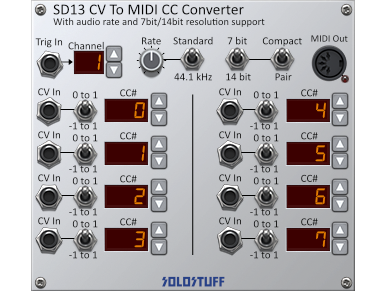Product Description
(This module is included in the System B)
The SD13 is a 8 section CV to MIDI CC (Control Change) messages converter. It supports both 7 bit and 14 bit messages with control over the rate of message generation.
Each section has a CV input, a CC# selection LED display and a voltage range switch. When the switch is set to 0V to 1V, the CV in expects voltages in this range (EG range). When –1V to 1V is chosen, this range is expected (LFO range). When in doubt, you can use the SE10 to figure out what voltage range you have.
The MIDI channel can be chosen manually by the LED digits buttons. The channel can also be increased or decreased by sending a positive or negative trigger to the Trig In (respectively). Notice that the channel number will cycle in a round robin fashion (It will go back to 1 when it increases above 16, and vise versa). This will allow you to cycle through the channels using CV by having a recurring positive (or negative) trigger.
Generated CC messages can be either 7bit for a resolution of 128 steps or 14bit for a higher resolution of 16384 steps. This can be chosen by a switch. Notice that the MIDI receiver (software or hardware) has to support 14bit MIDI for it to work properly. If you hear stepping while modulating some parameters, it’s probably because the receiver doesn’t support or hasn’t been configured to support 14bit CC. However, if there is no stepping that doesn’t necessarily mean that the receiver supports 14bit CC, it could be that the receiver is doing some smoothing internally.
14bit CC requires two values/messages. Course (MSB) and Fine (LSB). 7bit sends only Course. The Compact/Pair switch chooses between two methods of sending 14bit CC messages. The Compact methods sends Course values only when it changes while always sending Fine values. This is a standard method in MIDI. The Pair method always sends both Course and Fine values, which requires more bandwidth. Use Pair only for compatibility issues when your receiver doesn’t work with Compact mode.
The Rate knob determines how fast the module poles the input CVs for values and converts them to MIDI messages. The higher, the smoother the output but also the more MIDI bandwidth and CPU it will consume. The near by switch sets the range at which the Rate knob works. In Standard mode, the Rate knob minimum rate is 10 poles/second and the maximum is about 781 poles/second which equates to the MIDI standard 3125 bytes/second. In 44.1kHz mode, the minimum is 700 poles/second and the maximum is 44.1k poles/second. Notice that this last option is an extremely high setting for the MIDI standard (specially for non-USB MIDI) and should probably not be used for sending MIDI to hardware unless you know that your hardware can handle it, Of-course, you could try, but expect hanging and problems.
Technical Details:
As it is obvious from the Rate knob description above. SoloRack can internally send and receive MIDI at a much higher rate than the MIDI standard. As a result it is advised to keep the Rate at or bellow the default setting if you intend to send MIDI outside SoloRack. Other plugins and your DAW may or may not be able to handle a very high Rate. MIDI over USB usually has a higher rate than old fashioned DIN MIDI. If you like geeking out things, you could experiment with different rates, try to find the lowest rate that sounds acceptable.
Each of the 8 sections gets a fair share of the set rate. This means that if the CV inputs are changing at relatively high speeds AND the Rate is also set high. It might not be possible to squeeze all that high rate data into a single MIDI output without having latency (large buffering in memory). In this case, the SD13 would automatically have to skim the incoming data to provide a fair chance to each input CV to eventually generate MIDI messages.


Reviews
There are no reviews yet.